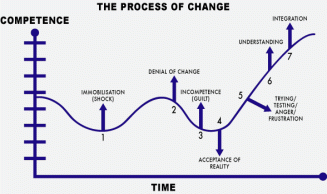… or to put it another way, if something around me changes, I need to change as well.
Change
By and large we don’t like change, unless we consider it to be positive. Change is worrying for
many reasons, perhaps the main one being that we have to remain conscious – we can’t afford to go to sleep because we don’t know what’s just around the corner, and it means we can’t rest; we feel that we have to be on our guard. This isn’t just ‘going with the flow’ stuff, it’s extremely practical. Perhaps it’s really about fearing and not fearing; it’s about taking life as it comes and adjusting to the new situation. As Alan Watts would have put it, this is ‘The Wisdom of Insecurity’.
It’s making your relationships work; it’s getting what you need out of your work; it’s about not being stressed by events; it’s about coming to terms with change, even when the change isn’t what you’d hoped for; and, not very surprisingly as this is about tai chi & qigong, it’s also doing both solo tai chi as well as doing partner-work.
Practising changing
Normally no one practises adaptability or change; there are no mechanisms in place, no lessons in school, no times in our lives when we deliberately work on accommodating change. By and large, we learn it through trial and error, with the help of parents and friends perhaps. Even then we don’t really focus on the process, we’re more interested in getting through the uncomfortable moments than in understanding the process and mastering it.
Practising adaptability in solo tai chi & qigong In solo practise, exactly the same thing is happening but is much harder to feel because no one is there to help you, you only have your own body. You therefore have to start paying attention to what is going on inside you, feeling how not only the sides of your body support each other, but also how the front and back, and the head and the feet do precisely the same. To take a couple of examples, if your left arm moves nearer your centreline, then your right arm somehow needs to create a balance. Or if your hands push forwards, then something needs to go backwards.
Practising adaptability with another person It’s easier to achieve this end in tai chi two-person work because you have to feel what is taking place in your body due to the changing pressures being exerted upon it by someone else.
How? First you create an event; for example, the simple action of your partner pushing against your arm. If you do nothing you will be pushed backwards. Symbolically the event has trashed you! The great thing about this is that, whereas most normal events only happen once, in this case you can get your partner to repeat the event as often as you want, i.e. you can practise.
So what do you do about the push? Perhaps you lift or lower your arm, or move it left or right… it’s not important, what is important is that you are finding the best way to deal with the issue, and what is more, you are starting to ‘listen’ to what is happening is the event, in this case the push. The more you listen, the more nuances you will find in the push; no single push will be the same as another.

You will start to notice the subtleties in: …Direction… …Speed… …Force… and how all of these can alter.
You will also start to notice: …How you tense or freeze… …How sometimes you only move one part of you without the rest being involved… …How difficult it is to find the balance between excess strength and weakness… …And then you’ll begin to notice how the person with whom you’re working has similar problems and, even whilst pushing you, doesn’t balance him/herself correctly.
Tai chi and qigong classes with James Drewe here.

